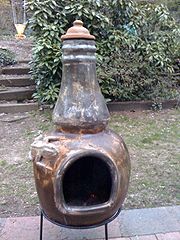
Chimenea
Encyclopedia
A chimenea is a freestanding front-loading fireplace
or oven with a bulbous body and usually a vertical smoke vent or chimney.
open fire garden heaters imported to the U.S. from Mexico
were known as chimeneas. As the story goes, chimeneas originated hundreds if not thousands of years ago by Mexican tribesmen who developed the chimeneas as a means of providing heat for their family as well as a vessel for cooking and baking. The original chimenea was designed to keep the rain off the fire and the family warm using merely a couple of sticks.

 Chimineas have become a popular backyard and deck
Chimineas have become a popular backyard and deck
accessory in the U.S., and also in the U.K. where they are often acquired as garden ornaments. Commonly, pinon
wood is burned for its aromatic scent and its bug repellent qualities. Unfortunately, the chimeneas currently imported are unable to withstand the thermal shock
associated with a sudden downpour of rain. Frequent problems encountered by owners include cracking, flaking glaze and crumbling of the clay. Admittedly the chimenea originates in Mexico where there is generally low rainfall and not exceptionally low temperatures and in general produces a radiant glow which is sufficient to keep warm. In Mexico, when the cooking pot or Chimenea cracked and fell apart, the people simply scooped some more mud
or river clay together and made another.
Fires start very quickly in chimineas after ignition with (news)papers and small pieces of wood. When in full burn after just 15 minutes, they give off tremendous heat due to their design which allows much more air to be drawn in than, for example, a fire basket.
Chimeneas made from cast iron or aluminum are also available. They can be of traditional shape or of many different designs. Most have a total height of about five feet and are about two feet across the firebox. Some metal chimineas have a grated door to close off the fireplace opening and a spark arrestor atop the stack. Metal chimeneas are much more durable than their clay cousins but are more expensive.
Fireplace
A fireplace is an architectural structure to contain a fire for heating and, especially historically, for cooking. A fire is contained in a firebox or firepit; a chimney or other flue allows gas and particulate exhaust to escape...
or oven with a bulbous body and usually a vertical smoke vent or chimney.
History
Originally, all clayClay
Clay is a general term including many combinations of one or more clay minerals with traces of metal oxides and organic matter. Geologic clay deposits are mostly composed of phyllosilicate minerals containing variable amounts of water trapped in the mineral structure.- Formation :Clay minerals...
open fire garden heaters imported to the U.S. from Mexico
Mexico
The United Mexican States , commonly known as Mexico , is a federal constitutional republic in North America. It is bordered on the north by the United States; on the south and west by the Pacific Ocean; on the southeast by Guatemala, Belize, and the Caribbean Sea; and on the east by the Gulf of...
were known as chimeneas. As the story goes, chimeneas originated hundreds if not thousands of years ago by Mexican tribesmen who developed the chimeneas as a means of providing heat for their family as well as a vessel for cooking and baking. The original chimenea was designed to keep the rain off the fire and the family warm using merely a couple of sticks.


Deck (building)
In architecture, a deck is a flat surface capable of supporting weight, similar to a floor, but typically constructed outdoors, often elevated from the ground, and usually connected to a building...
accessory in the U.S., and also in the U.K. where they are often acquired as garden ornaments. Commonly, pinon
Pinyon pine
The pinyon pine group grows in the southwestern United States and in Mexico. The trees yield edible pinyon nuts, which were a staple of the Native Americans, and are still widely eaten...
wood is burned for its aromatic scent and its bug repellent qualities. Unfortunately, the chimeneas currently imported are unable to withstand the thermal shock
Thermal shock
Thermal shock is the name given to cracking as a result of rapid temperature change. Glass and ceramic objects are particularly vulnerable to this form of failure, due to their low toughness, low thermal conductivity, and high thermal expansion coefficients...
associated with a sudden downpour of rain. Frequent problems encountered by owners include cracking, flaking glaze and crumbling of the clay. Admittedly the chimenea originates in Mexico where there is generally low rainfall and not exceptionally low temperatures and in general produces a radiant glow which is sufficient to keep warm. In Mexico, when the cooking pot or Chimenea cracked and fell apart, the people simply scooped some more mud
Mud
Mud is a mixture of water and some combination of soil, silt, and clay. Ancient mud deposits harden over geological time to form sedimentary rock such as shale or mudstone . When geological deposits of mud are formed in estuaries the resultant layers are termed bay muds...
or river clay together and made another.
Fires start very quickly in chimineas after ignition with (news)papers and small pieces of wood. When in full burn after just 15 minutes, they give off tremendous heat due to their design which allows much more air to be drawn in than, for example, a fire basket.
Chimeneas made from cast iron or aluminum are also available. They can be of traditional shape or of many different designs. Most have a total height of about five feet and are about two feet across the firebox. Some metal chimineas have a grated door to close off the fireplace opening and a spark arrestor atop the stack. Metal chimeneas are much more durable than their clay cousins but are more expensive.

